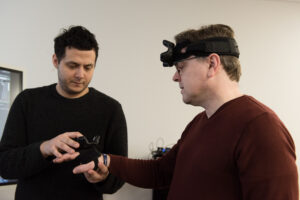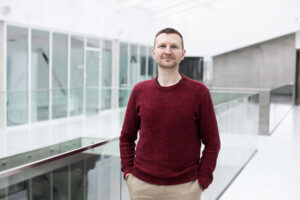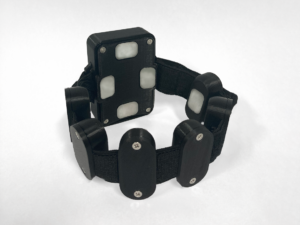“Our team was responsible for the system, and the colleagues from other Lithuanian universities developed the biomechanics model (a model of the muscles and their movements) and carried out the testing,” says Maskeliūnas.
The system benefits not only the patient but also the professional
“Our new methodology with electromyography (EMG) elements is particularly important for proper exercise design during a rehabilitation programme. With this new technology, you can see exactly which muscle is working and at what capacity, how it reacts to the load and how quickly it recovers. This information allows the specialist to work with the patient not blindly, but knowing exactly which muscles are working well, which are overworked, or which are not even tired,” says Aušra Adomavičienė, a researcher at the Faculty of Medicine at Vilnius University (VU MF).
In her opinion, such technology is not only a great help to the rehabilitation specialist, but it is equally essential for the patient, who, with such technology, can continue the exercises at home, see the progress, and feel safe and secure, without doubts about whether they are doing it right, or whether they are harming themselves, etc.
“This system is important for patients with musculoskeletal disorders or diseases that require the restoration of lost movement and mobility function, which is directly caused by reduced or lost muscle function. These are the patients who have suffered a cerebral infarction, various traumas, fractures, soft tissue or nerve damage, systemic diseases such as Multiple Sclerosis or Parkinson’s Disease,” says Adomavičienė.
The researcher points out that this innovative technology can also be used for wellness purposes. For example, people who, due to irregular, poor working posture, or repetitive movements at work that strain one segment of the body, have muscular imbalances in their bodies, and often experience chronic pain (back, shoulder or wrist) or fatigue. According to Adomavičienė, the simple, user-friendly and easy-to-use technology is suitable for people of any age, whether child or adult.
These technologies are our future
“I think that after 20 years, patients and professionals involved in rehabilitation will not even be able to imagine that during functional assessment, testing and programme execution, they were guided by the subjective, hand-held instruments that we now use on a daily basis,” says Adomavičienė.
According to her, computerised and intelligent systems based on artificial intelligence strategies will not only be able to identify in detail the problems experienced by the patient, but after the assessment, they will be able to analyse, systematise and provide feedback, i.e. to provide information and recommendations during the live sessions on how to adjust the rehabilitation programme individually according to the patient’s situation to increase tolerance to physical load, activate recovery mechanisms and the healing process.
KTU researcher Maskeliūnas agrees with his colleague: “Future research should also look at the development of individualised treatment plans and the adaptation of the algorithm to respond to a wider range of possible actions, taking into account the individual needs of the patient.”
Although the study evaluated the accuracy of the system in measuring hand movement patterns, the long-term impact on functional recovery in stroke patients needs to be further investigated, including the integration of this approach with other therapies such as occupational and physical therapy, according to Maskeliūnas.



